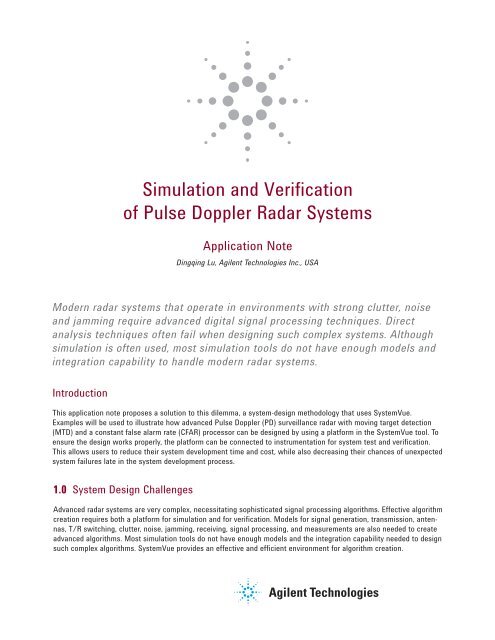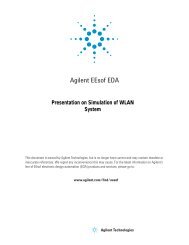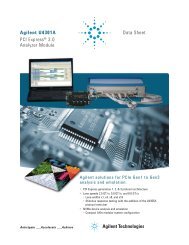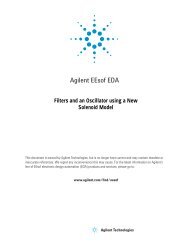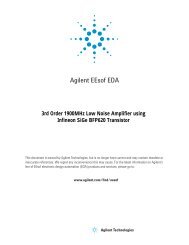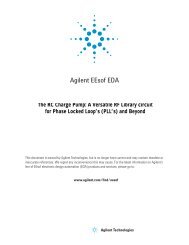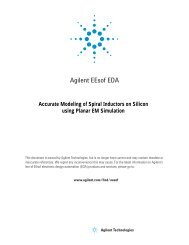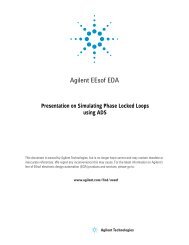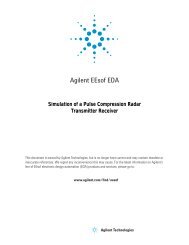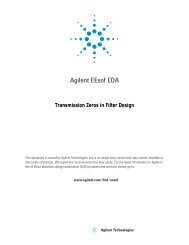Simulation and Verification of Pulse Doppler Radar Systems
Simulation and Verification of Pulse Doppler Radar Systems
Simulation and Verification of Pulse Doppler Radar Systems
Create successful ePaper yourself
Turn your PDF publications into a flip-book with our unique Google optimized e-Paper software.
<strong>Simulation</strong> <strong>and</strong> Verifi cation<br />
<strong>of</strong> <strong>Pulse</strong> <strong>Doppler</strong> <strong>Radar</strong> <strong>Systems</strong><br />
Application Note<br />
Dingqing Lu, Agilent Technologies Inc., USA<br />
Modern radar systems that operate in environments with strong clutter, noise<br />
<strong>and</strong> jamming require advanced digital signal processing techniques. Direct<br />
analysis techniques <strong>of</strong>ten fail when designing such complex systems. Although<br />
simulation is <strong>of</strong>ten used, most simulation tools do not have enough models <strong>and</strong><br />
integration capability to h<strong>and</strong>le modern radar systems.<br />
Introduction<br />
This application note proposes a solution to this dilemma, a system-design methodology that uses SystemVue.<br />
Examples will be used to illustrate how advanced <strong>Pulse</strong> <strong>Doppler</strong> (PD) surveillance radar with moving target detection<br />
(MTD) <strong>and</strong> a constant false alarm rate (CFAR) processor can be designed by using a platform in the SystemVue tool. To<br />
ensure the design works properly, the platform can be connected to instrumentation for system test <strong>and</strong> verification.<br />
This allows users to reduce their system development time <strong>and</strong> cost, while also decreasing their chances <strong>of</strong> unexpected<br />
system failures late in the system development process.<br />
1.0 System Design Challenges<br />
Advanced radar systems are very complex, necessitating sophisticated signal processing algorithms. Effective algorithm<br />
creation requires both a platform for simulation <strong>and</strong> for verification. Models for signal generation, transmission, antennas,<br />
T/R switching, clutter, noise, jamming, receiving, signal processing, <strong>and</strong> measurements are also needed to create<br />
advanced algorithms. Most simulation tools do not have enough models <strong>and</strong> the integration capability needed to design<br />
such complex algorithms. SystemVue provides an effective <strong>and</strong> efficient environment for algorithm creation.
2.0 Signal Processing Algorithm Creation<br />
The system-design methodology proposed below uses<br />
SystemVue. It concentrates on algorithm design for PD<br />
radar systems. The development <strong>of</strong> MTD <strong>and</strong> CFAR processors<br />
in a time-efficient manner are used as examples<br />
to better underst<strong>and</strong> this methodology.<br />
To begin, consider the tasks undertaken by the radar DSP<br />
algorithm designer, which typically breaks down into the<br />
following two stages:<br />
Stage 1. Design the algorithm in s<strong>of</strong>tware <strong>and</strong><br />
verify it using a simulation tool.<br />
To accomplish this task, the designer needs:<br />
• A user-friendly algorithm modeling environment to<br />
easily create <strong>and</strong> debug the algorithm during algorithm<br />
development. The environment should support multiple<br />
languages, such as m-code*, C++ <strong>and</strong> HDL.<br />
• Signal sources <strong>and</strong> measurements to verify the<br />
algorithm during verification, once it is created.<br />
Unfortunately, it is not a simple task for the DSP algorithm<br />
designer to create radar signal sources with radar<br />
cross section (RCS), clutters, noise, <strong>and</strong> jamming. The<br />
designer might also encounter difficulty creating measurements<br />
for the algorithm. Consequently, a tool that<br />
provides radar sources <strong>and</strong> measurements is desired.<br />
Stage 2. Implement <strong>and</strong> test the algorithm<br />
in hardware.<br />
After the algorithm testing <strong>and</strong> verification are finished, it<br />
needs to be implemented in hardware. To accomplish this<br />
task, a hardware test platform must be created.<br />
To address these needs when creating the MTD <strong>and</strong><br />
CFAR processor, a platform that provides the following<br />
functionality is required:<br />
• An interface to a vector signal generator to generate<br />
test signals. The vector signal generator provides<br />
radar signal-generation test sources <strong>and</strong> models<br />
for RCS parameters, Clutter, Jamming, <strong>Doppler</strong>, <strong>and</strong><br />
Frequency <strong>of</strong>fset.<br />
• An interface to a vector signal analyzer to verify the<br />
implemented hardware as compared to the original<br />
pure algorithm. The platform must support a wide<br />
range <strong>of</strong> measurements including waveforms, spectra,<br />
detection rate, <strong>and</strong> false alarm rate (FAR). Also it must<br />
provide an estimation <strong>of</strong> target distance, speed <strong>and</strong><br />
angles for the detected target.<br />
As will be shown, SystemVue provides a platform to meet<br />
all <strong>of</strong> these needs when creating radar algorithms.<br />
*SystemVue has a built-in m-code compatible<br />
processor, called MathLang, which is available for use<br />
throughout the program. Existing m-code files can also<br />
be directly incorporated into a design. In addition, it<br />
has the capability <strong>of</strong> co-simulating with MATLAB, from<br />
The MathWorks <strong>of</strong> Natick, MA.<br />
2
3.0 SystemVue as a Platform<br />
for <strong>Simulation</strong><br />
The top-level system platform structure is shown in Figure<br />
3-1. From the block diagram, the main models include signal<br />
source, transmitter, antenna, T/R switch, RCS, clutter,<br />
jammer, receiver, signal processors, <strong>and</strong> measurements.<br />
Sub libraries are also listed. The major task is how the<br />
designer creates their own algorithm using SystemVue.<br />
Platform for simulation<br />
Figure 3-1. SystemVue as a platform for simulation<br />
3
4.0 SystemVue as a Platform for Test<br />
SystemVue can be used as a test platform for verification<br />
<strong>of</strong> the integrated system at each stage <strong>of</strong> development.<br />
This is done by connecting algorithms, instruments <strong>and</strong><br />
test hardware together based on the created algorithm.<br />
In SystemVue, an interface model (sink) allows for direct<br />
connections with various signal generators as shown in<br />
Figure 4-1. This allows s<strong>of</strong>tware data to be downloaded to<br />
instruments for hardware test data. Figure 4-2 shows the<br />
details for using the platform to connect to instruments<br />
<strong>and</strong> test hardware based on the created algorithm.<br />
Figure 4-1. SystemVue as a platform for test<br />
4
Platform – Generate test signals<br />
Figure 4-2. Generate test signals using SystemVue<br />
Platform – Exp<strong>and</strong> measurements<br />
Figure 4-3. Exp<strong>and</strong>ing measurement capabilities using SystemVue<br />
SystemVue can also connect to signal analyzers, logic<br />
analyzers or scopes to provide additional measurements<br />
<strong>and</strong> exp<strong>and</strong> instrument capability according to the user’s<br />
needs. As an example, Figure 4-3, shows the link between<br />
SystemVue <strong>and</strong> a signal analyzer. Here, test signals from<br />
the signal generator are sent to the device-under-test<br />
(DUT). The signal analyzer captures the DUT output<br />
waveforms <strong>and</strong> sends them to SystemVue, using the<br />
Vector Signal Analyzer (VSA) link model. In SystemVue,<br />
the waveform can be further processed using the radar<br />
signal processing function. SystemVue also provides<br />
additional meassurements such as <strong>Doppler</strong> frequency,<br />
detection probability <strong>and</strong> false alarm probability.<br />
5
5.0 Principles <strong>of</strong> the PD <strong>Radar</strong> System<br />
To better underst<strong>and</strong> the proposed system design methodology,<br />
consider the design <strong>of</strong> PD radar algorithms. PD<br />
radars are extremely valuable for finding small moving<br />
targets hidden by heavily cluttered environments <strong>and</strong><br />
are used in both military <strong>and</strong> commercial applications.<br />
Unlike continuous waveform (CW) radar, PD radar has<br />
the ability to detect angle, distance <strong>and</strong> also velocity.<br />
Typical examples include weather, low-flying aircraft <strong>and</strong><br />
anti-ship missiles.<br />
For this discussion, we focus on airborne PD radar that<br />
is trying to detect a moving target near the ground or<br />
the sea. In this case, the moving target returned signal<br />
is much weaker than the clutter from the ground or sea.<br />
As shown in Figure 5-1, the target signal is hidden by a<br />
heavily cluttered environment. Consequently, it is almost<br />
impossible to detect the target in the time domain using<br />
regular radar processing.<br />
Figure 5-1. Target signal hidden by heavily cluttered environment<br />
The radar transmission signal <strong>and</strong> returned signal [1] can<br />
be expressed as:<br />
S(t) = A(t)Cos(2πj c<br />
t)<br />
S(t - τ) = A(t)Cos(2π( f c<br />
+ f d<br />
)t – τ) + N c<br />
(t) + N n<br />
(t) + N j<br />
(t)<br />
where f d<br />
is the <strong>Doppler</strong> frequency, τ is the delay, <strong>and</strong> Nc,<br />
Nn <strong>and</strong> Nj refer to clutter, noise <strong>and</strong> jamming, respectively.<br />
To detect target speed <strong>and</strong> distance, f d<br />
<strong>and</strong> τ must be<br />
estimated.<br />
6
Because the small moving targets are hidden by the<br />
heavily cluttered environments, they can not be detected<br />
in the time domain. Instead, the signal must be detected<br />
in the frequency domain using <strong>Doppler</strong> frequency analysis.<br />
To do this, return data must be collected <strong>and</strong> processed<br />
using two dimensional (2D) signal analysis for both target<br />
speed <strong>and</strong> distance. 2D signal processing is required for<br />
moving target indicator (MTI) <strong>and</strong> MTD. CFAR processing<br />
is needed for auto-detection in PD signal processing.<br />
Without CFAR, auto-detection will likely fail.<br />
Sampling Interval<br />
= PRI<br />
Sampling Interval<br />
= 1/BW<br />
Range bins<br />
Figure 5-2. 2D signal processing for moving target detection<br />
<strong>Doppler</strong> Frequency Extract<br />
The first step in PD signal processor development is to<br />
design a data bank to store received timed signals, as<br />
shown in Figure 5-2. The received data is entered into the<br />
data bank point-by-point from one column to another until<br />
the bank is full.<br />
Taking a closer look at each column, the time interval<br />
for each data point is 1/b<strong>and</strong>width. Each data point is<br />
a return signal from different distances. The sampling<br />
interval between each column is the pulse signal<br />
repetition interval. All data points in the same row are<br />
returned from the same distance with different timing.<br />
<strong>Doppler</strong> frequency can be extracted from data in the rows.<br />
Either a filter bank or a group <strong>of</strong> fast Fourier transform<br />
(FFT) operations can be used for all data points in the data<br />
bank. In s<strong>of</strong>tware design, a group <strong>of</strong> FFTs is always used.<br />
Once the <strong>Doppler</strong> frequency is detected, the location <strong>of</strong><br />
the row can be mapped to the return target distance from<br />
the range bins. Then, the distance can be detected.<br />
7
6.0 PD <strong>Radar</strong> System Structure<br />
Figure 6-1 depicts the top-level structure <strong>of</strong> a PD radar system<br />
in SystemVue. Since we are interested in creating an<br />
algorithm for PD signal processing, this discussion focuses<br />
on the PD signal processing, including MTD <strong>and</strong> CFAR. For<br />
other blocks, just a brief introduction is provided.<br />
PD <strong>Radar</strong> System Structure<br />
Figure 6-1. PD radar structure<br />
6.1 Signal Sources<br />
For this example, signal sources include:<br />
• <strong>Pulse</strong> signal generator<br />
• Linear FM pulse signal generator<br />
• Nonlinear FM signal generator<br />
• Polyphase code generator<br />
6.2 Target Return Model<br />
The target return model includes:<br />
• RCS, <strong>Doppler</strong> effect, delay <strong>and</strong> attenuation<br />
• Fluctuant RCS types: Swirling 0, I, II, III, <strong>and</strong> IV linear<br />
FM pulse signal generator<br />
S r<br />
(t – t r<br />
) = kA(t – t r<br />
) cos[2π( f 0<br />
± f d<br />
)t – 4πR 0<br />
/λ + φ] • U(t – t r<br />
)<br />
where R 0<br />
is the distance between radar <strong>and</strong> the target,<br />
<strong>and</strong> t r<br />
is the path delay, so t r<br />
=2R/c.<br />
8
6.3 Clutter Models<br />
Since this is the system-level simulation, behavioral models<br />
can be used to describe the functionality. We focus<br />
on the probability distribution functions (PDFs) <strong>and</strong> power<br />
spectrum densities (PSDs) that are good enough to model<br />
the system performance, but the physical-level model is<br />
not provided here. If required by the user, this service can<br />
be provided. SystemVue <strong>of</strong>fers a choice <strong>of</strong> four PDFs <strong>and</strong><br />
three PSDs, which include:<br />
• PDF<br />
• Rayleigh<br />
• Log-Normal<br />
• Weibull<br />
• K–Distribution<br />
• PSD<br />
• Gaussian<br />
• Cauchy<br />
• All Pole<br />
The user can also define any distribution using<br />
SystemVue’s built-in MathLang capabilities.<br />
6.4 <strong>Radar</strong> RF Transmitters <strong>and</strong> Receivers<br />
Here we provide the behavioral model’s structure. If<br />
desired, the SpectraSys RF link enables the user to go<br />
down to the circuit level. Another way to model complex<br />
frequency dependent behavior is to import S-parameters<br />
using the SData model in SystemVue. An example <strong>of</strong><br />
using the SData model is shown in Figure 6-5.<br />
As shown in Figure 6-2, the RF transmitter features local<br />
oscillators, which can include phase noise, modulators<br />
<strong>and</strong> mixers with non-ideal behavior, <strong>and</strong> amplifiers which<br />
can include complex nonlinear behaviors <strong>and</strong> filters.<br />
Figure 6-3 depicts the RF receiver’s oscillators,<br />
demodulator, amplifiers, <strong>and</strong> filters.<br />
Figure 6-2. RF transmitter<br />
Figure 6-3. RF receiver<br />
9
6.5 Digital Up/Down Converter (DUC/DDC)<br />
for Digital IF<br />
The two models depicted in Figure 6-4 are very useful for<br />
creating new DSP models with certain algorithms.<br />
Figure 6-4. Digital up/down converters<br />
6.6 Antenna Models<br />
The antenna model structure shown in Figure 6-5 was<br />
created using a SystemVue SData model. If the user<br />
knows the antenna’s Gain as a function <strong>of</strong> Deflection<br />
Angle, Modeled with S-parameters, the simulation model<br />
can be easily structured. Figure 6-5 also shows the<br />
antenna measurements.<br />
Figure 6-5. Antenna structure<br />
10
6.7 <strong>Pulse</strong> Compression<br />
Figure 6-6 depicts the PD processing pulse compression.<br />
Digital<br />
2D I/Q Matrix<br />
DFT<br />
IDFT<br />
Compressed<br />
Digital<br />
2D I/Q Matrix<br />
Reference<br />
Waveform<br />
DFT with<br />
zero padding<br />
Spectrum<br />
Windowing<br />
Figure 6-6. <strong>Pulse</strong> compression in frequency domain for PD processing<br />
6.8 Moving Target Indicator<br />
The basic idea behind the MTI is to filter the clutter<br />
at or very near DC, while keeping the other spectrum<br />
region flat. As shown in Figure 6-7, a three-pulse (double,<br />
second-order) canceller can be formed by cascading two<br />
first-order sections using a transfer function.<br />
x[n]<br />
H(z) = 1 – 2z –1 + z –2 z –1 +<br />
+ Σ Σ<br />
y[n]<br />
z –1<br />
Figure 6-7. Moving target indicator<br />
6.9 Moving Target Detector<br />
The MTD is a key processor for PD radar [2]. A bank <strong>of</strong><br />
<strong>Doppler</strong> filters or FFT operators cover all possible expected<br />
target <strong>Doppler</strong> shifts (Figure 6-8). The input data is collected<br />
in a repetition period by using a data bank. Data<br />
points within the same range are then correlated <strong>and</strong><br />
processed until all data in the data bank is processed.<br />
There are two ways to do the 2D signal processing, either<br />
using a filter bank or group <strong>of</strong> FFT. In the example, a group<br />
<strong>of</strong> FFTs is used to operate on each row in the data bank to<br />
detect f d<br />
. Delay is then detected by looking at the detected<br />
data point location for range bins.<br />
Delay Estimation<br />
for the Range bin<br />
Filtering Bank<br />
Or spectra<br />
Estimation for<br />
<strong>Doppler</strong> Freq<br />
Range bins<br />
Figure 6-8. Signal Processing in MTD<br />
For <strong>Doppler</strong> Frequency<br />
11
Once the algorithm is understood, the code can be derived<br />
using C++ or MathLang. During its development, the<br />
code can be easily debugged for either C++ or MathLang<br />
as shown from Figure 6-9. Users can modify the code or<br />
insert their own in the code window to implement their<br />
own MTD algorithm.<br />
PD <strong>Radar</strong> System – MTD Model<br />
– The MTD model created using Math Language<br />
Figure 6-9. MTD implemented by using MathLang<br />
6.10 CFAR Processor<br />
Since modern radar requires auto detection, PD radar<br />
must use CFAR to control the false alarm rate. Otherwise,<br />
the radar won’t work. The CFAR can be done in time or<br />
frequency domains or both. Instead <strong>of</strong> the fixed detection<br />
threshold, the averaging amplitude value <strong>of</strong> reference cells<br />
is used as the threshold in order to prevent false alarms<br />
from happening too frequently (Figure 6-10). This CFAR<br />
system is called a cell averaging (CA) CFAR system.<br />
In the PD radar example in this application note, CFAR<br />
was done in the frequency domain. Cell averaging CFAR<br />
was used.<br />
PD <strong>Radar</strong> System – CA CFAR<br />
– Test cell: the detected cell<br />
– Guard or gap cell: value not to be included in the<br />
interference estimate due to possible target contamination<br />
– Reference cell: values assumed to be interference only,<br />
thus used to estimate interference parameters<br />
Figure 6-11. CA CFAR processor code implementation<br />
12
PD <strong>Radar</strong> System – CFAR Model<br />
– The CFAR model created using Math Language<br />
Figure 6-10. Cell averaging CFAR processor<br />
Once the algorithm is understood, the code can be derived<br />
using C++ or MathLang. During its development, the code<br />
can be easily debugged for either C++ or MathLang as<br />
shown from Figure 6-11. Users can modify the code or<br />
insert their own in the code window to implement their<br />
own CFAR algorithm.<br />
6.11 Measurements<br />
Models have been implemented to do the following measurements:<br />
• Basic Measurements<br />
– Waveform<br />
– Spectrum<br />
– Signal noise ratio<br />
• Advanced Measurements<br />
– Estimation <strong>of</strong> distances <strong>and</strong> speeds<br />
– Detection probability, Pd = number <strong>of</strong> successful<br />
detection/total number <strong>of</strong> tests<br />
– False alarm probability, Pf = number <strong>of</strong> false errors/<br />
total number <strong>of</strong> tests<br />
– Importance sampling will be implemented to speed up<br />
the Pf simulation [3]<br />
If the user wants more, custom measurement models can<br />
be created using a combination <strong>of</strong> existing models.<br />
13
7.0 <strong>Simulation</strong> <strong>of</strong> PD <strong>Radar</strong> System<br />
The PD design shown in Figure 6-1 is simulated. All key<br />
parameters can be set at the Parameter table defined for<br />
the PD simulation system as shown in Figure 7-1. The<br />
user can very easily edit, add or delete any parameter.<br />
7.1 <strong>Simulation</strong> Results<br />
Before PD processing, at the receiver input, the target<br />
signal cannot be recognized <strong>and</strong> the target is hidden by<br />
strong clutter environment (Figure 7-2). However, after<br />
the 2D PD processing, the target is detected. After PD<br />
<strong>and</strong> CFAR, clean target detection is achieved.<br />
Figure 7-1. <strong>Simulation</strong> setup table<br />
Figure 7-2. PD detection <strong>of</strong> a moving target<br />
14
In Figure 7-3, the detection probability <strong>of</strong> the system is displayed.<br />
The detection rate is obtained by running a number<br />
<strong>of</strong> tests <strong>and</strong> coming up with the detect rate using the Pd<br />
definition. The target distance <strong>and</strong> speed are estimated<br />
using the detected <strong>Doppler</strong> frequency <strong>and</strong> the detected<br />
range bin location.<br />
Figure 7-3. System detection rate <strong>and</strong> estimated target distance <strong>and</strong> speed<br />
8.0 Summary<br />
Algorithms are critical for high-performing advanced radar<br />
systems. A unified approach to radar system design that<br />
relies on SystemVue now <strong>of</strong>fers designers a viable means<br />
<strong>of</strong> creating effective algorithms. It provides a user-friendly<br />
environment for algorithm development, while also integrating<br />
s<strong>of</strong>tware <strong>and</strong> hardware to verify the algorithms.<br />
SystemVue can even be used to develop algorithms for<br />
digital array radar plus space-time adaptive processing<br />
(STAP) <strong>and</strong> multiple-input multiple-output (MIMO) radar.<br />
Moreover, it allows the system development team to<br />
quickly <strong>and</strong> easily try new <strong>and</strong> innovative ideas <strong>and</strong> to<br />
evaluate the effects <strong>of</strong> jamming <strong>and</strong> interference sources<br />
on radar performance.<br />
15
9.0 References<br />
1. I. Skolnik, <strong>Radar</strong> H<strong>and</strong>book, 2nd ed. McGraw-Hill Inc., 1990.<br />
2. D. Curtis Schleher, MTI <strong>and</strong> <strong>Pulse</strong> <strong>Doppler</strong> <strong>Radar</strong>,<br />
Artech House, Inc., 1991.<br />
3. Dingqing Lu <strong>and</strong> Kong Yao, Importance Sampling<br />
<strong>Simulation</strong> Techniques Applied to Estimating False<br />
Alarm Probabilities, Proc. IEEE ISCAS, 1989, pp. 598-601.<br />
Additional radar resources from Agilent:<br />
• www.agilent.com/find/radar<br />
• SystemVue home page:<br />
www.agilent.com/find/ees<strong>of</strong>-systemvue<br />
• SystemVue videos:<br />
www.agilent.com/find/ees<strong>of</strong>-systemvue-videos<br />
www.agilent.com<br />
www.agilent.com/find/ees<strong>of</strong>-systemvue<br />
For more information on Agilent<br />
Technologies’ products, applications or<br />
services, please contact your local Agilent<br />
<strong>of</strong>fice. The complete list is available at:<br />
www.agilent.com/find/contactus<br />
Americas<br />
Canada (877) 894 4414<br />
Latin America 305 269 7500<br />
United States (800) 829 4444<br />
Asia Pacific<br />
Australia 1 800 629 485<br />
China 800 810 0189<br />
Hong Kong 800 938 693<br />
India 1 800 112 929<br />
Japan 0120 (421) 345<br />
Korea 080 769 0800<br />
Malaysia 1 800 888 848<br />
Singapore 1 800 375 8100<br />
Taiwan 0800 047 866<br />
Thail<strong>and</strong> 1 800 226 008<br />
Europe & Middle East<br />
Austria 43 (0) 1 360 277 1571<br />
Belgium 32 (0) 2 404 93 40<br />
Denmark 45 70 13 15 15<br />
Finl<strong>and</strong> 358 (0) 10 855 2100<br />
France 0825 010 700*<br />
*0.125 €/minute<br />
Germany 49 (0) 7031 464 6333<br />
Irel<strong>and</strong> 1890 924 204<br />
Israel 972-3-9288-504/544<br />
Italy 39 02 92 60 8484<br />
Netherl<strong>and</strong>s 31 (0) 20 547 2111<br />
Spain 34 (91) 631 3300<br />
Sweden 0200-88 22 55<br />
Switzerl<strong>and</strong> 0800 80 53 53<br />
United Kingdom 44 (0) 118 9276201<br />
Other European Countries:<br />
www.agilent.com/find/contactus<br />
Revised: October 1, 2009<br />
Product specifications <strong>and</strong> descriptions<br />
in this document subject to change<br />
without notice.<br />
MATLAB is a U.S. registered trademark<br />
<strong>of</strong> The Math Works, Inc.<br />
© Agilent Technologies, Inc. 2010<br />
Printed in USA, April 12, 2010<br />
5990-5392EN


